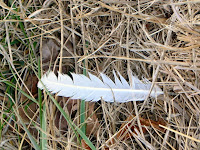At first, the painting appears perfectly realistic, until you realize the clever way Magritte has played with light. Part of the front of the house is illuminated by an artificial light near the door, in just the way it would appear at night. But above, the sky is light blue, just as if it were day. It's neither night nor day but impossibly both!
That illusion is so similar to the light I saw as I stepped outside just before daybreak. What first caught my eye were the white clouds above the house across the street, along with a couple stars visible above the clouds in the night sky. As I turned my head upward, I saw that the same very white clouds formed a ring all around me, a nearby treetop blocking only a small part of my view of them. Straight above me was a large opening in the white clouds, revealing the dark night sky with a few more stars visible.
But how could this be? If the sky told me it was night, how could the clouds be so white? The reason was that they were illuminated by all the artificial lights of city, which I could not see directly. Just like Magritte's painting, what appeared to be totally natural was, in fact, a fusion of the natural and the artificial.
To me, this experience stands as a metaphor of who we human beings are in relationship to the natural world: Our human lives are part of both natural processes and our humanly-created cultures. We are in one way a part of Nature, and in another way not. In trying to describe who we are, drawing upon our contemporary scientific knowledge about biological and cultural evolution, some contemporary writers are increasingly using the word "emergent." We humans, relying so much upon our cultural artifacts, are an emergent species.
Another metaphor that proves helpful to me in understanding our human emergence is that of a strikingly colored flower on the tip of the stem of a plant. Just like the colorful flower, we stand out as something different, even though we would die if we were cut off from the plant.
Back in the 2nd century, the Christian theologian Irenaeus also spoke about human emergence, without confining God's spirit to the human realm. Irenaeus wrote: "God sleeps in a stone, dreams in a flower, moves in an animal, and wakes in man."
No individual human could survive without either Nature or human culture. That is our dilemma. Maybe we can make it our joy.
~~~
In what ways do you think we are more than a part of Nature? In what ways a part of Nature?
(The detail from the Magritte painting "The Empire of Light,"
© 1950 Museum of Modern Art, is used here through Fair Use.)






